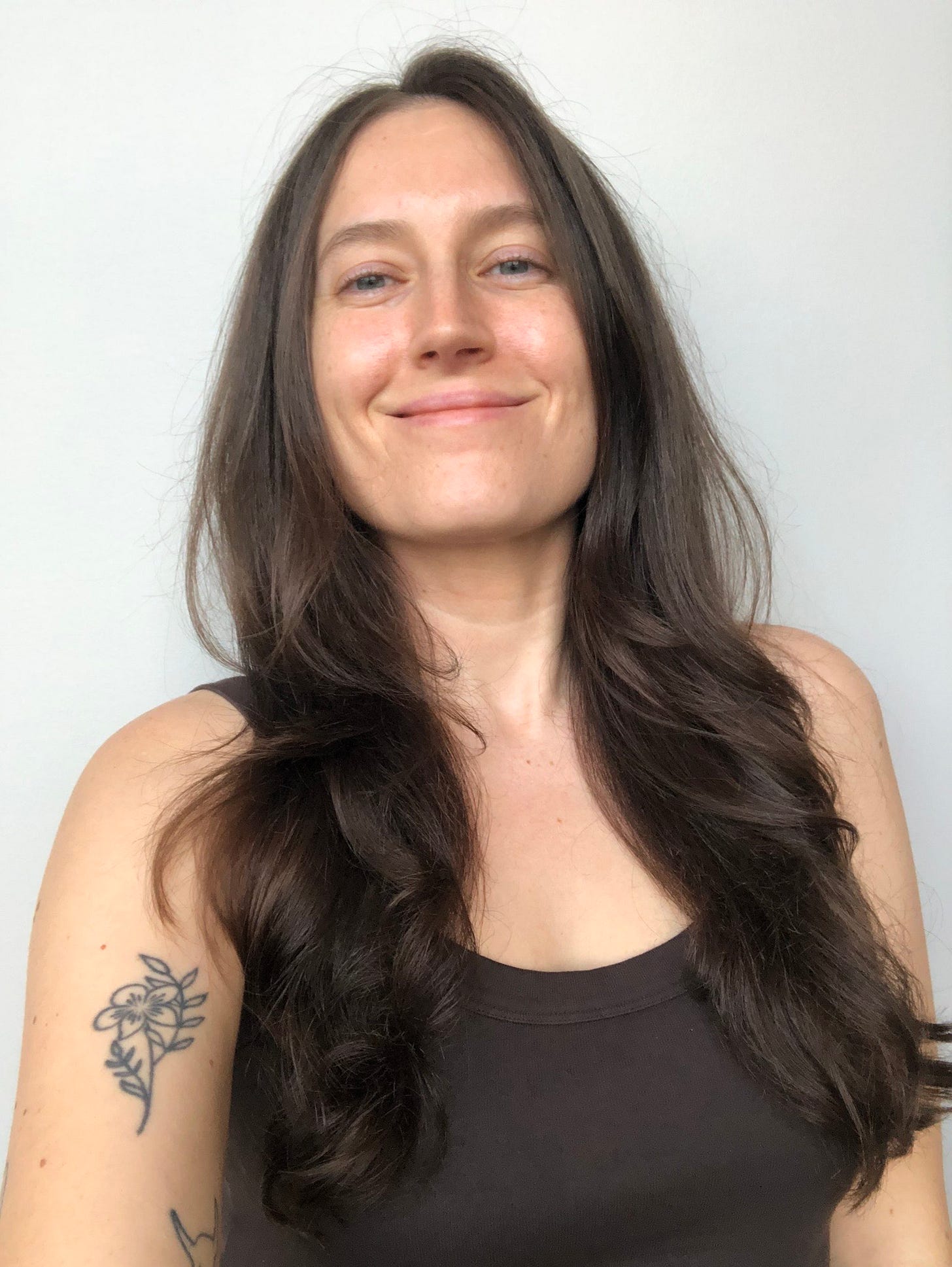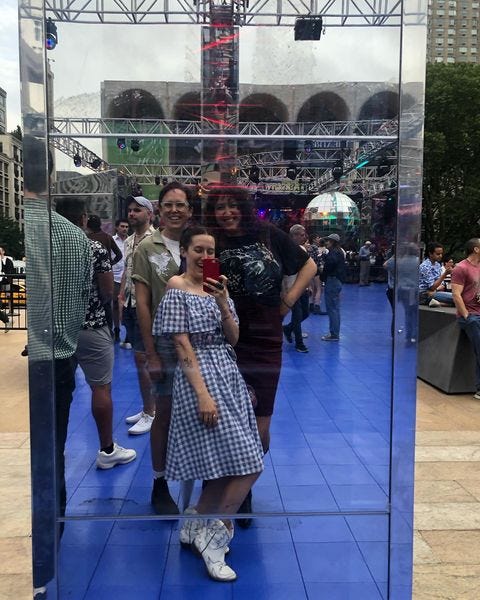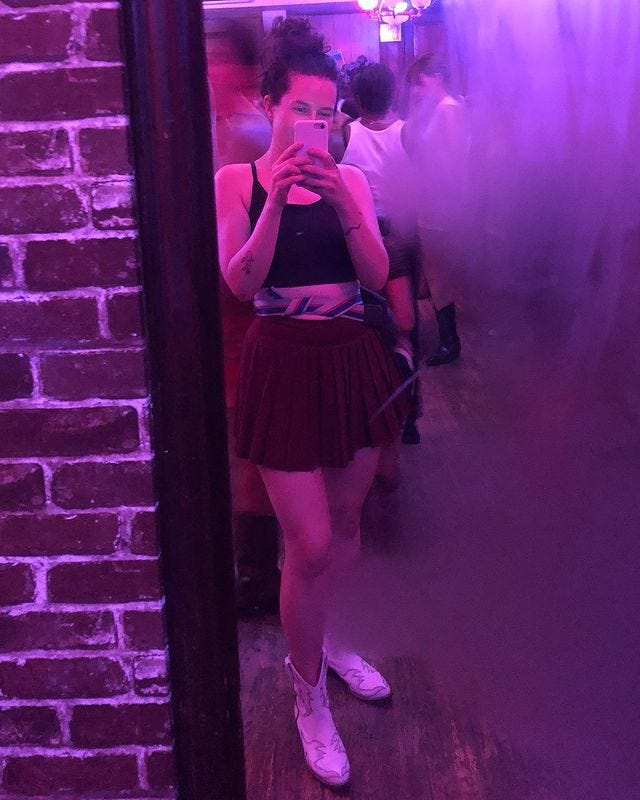Line dancing with Blythe Roberson
cowboy emoji
Welcome to Thinking About Getting Into: a newsletter about interesting people with interests.
Blythe Roberson felt reluctant about line dancing. But once she got into the groove, she found a new world of movement open up to her. The comedy writer and author of America the Beautiful? and How to Date Men When You Hate Men—who’s also written for The New Yorker and New York Magazine, among others—shares how one “religious experience” at Lincoln Center kicked off her newfound love of dance.
What first brought you to line dancing? How did you get to your first class?
I knew vaguely about it. Then, in June of this year, my friend Madelyn invited me to go to an event at Lincoln Center—she was like, “It's gay line dancing,” and I was like, “Great, sounds cool.” Then, the day of, I was just not feeling it at all. It was one of those moments when I didn't want to leave my apartment or go see a lot of people. And I desperately tried to make plans to do literally anything else. I texted my friend Ian asking if he wanted to hang out and he was like, “I’m busy, but my ex-girlfriend does those line dancing things, so if you see her, you should say hi.”
Eventually, I was like, “Look, I guess I'm gonna go to this fucking line dancing thing.” I dressed up in my little cowgirl outfit, and I went, and it was a religious experience. It was so great. To be around other people who were all dressed up in their little gay cowgirl outfits and to be there with my friends on a beautiful, early summer night in this incredible city, in this crazy space where Cher and Nick Cage were in Moonstruck, and to learn very simple choreography with just a bunch of other people that you didn't know—it was so much better than I ever thought it would be.
And I did see Ian’s ex-girlfriend and she was like, “You have to follow this woman on Instagram. She does classes every week.”
What kind of music do you usually line dance to?
It's a mix between the songs you would think that line dances would be danced to—we learned one to “She Thinks My Tractor's Sexy,” and another one to “Country Girl (Shake It For Me)” by, I think, one of those guys named Luke. One of the most popular ones is “Shivers” by Ed Sheeran. Tenaya [Kelleher], who leads the classes, choreographs a lot of dances herself, and she'll do them to [artists like] Janet Jackson.
What is your line-dancing outfit? Has that changed over time? Like, did you eventually buy more cowboy boots or something?
The boots are something that everyone across the board wears because they are actually better for dancing. You want a leather sole to move around. I had one pair that was comfortable for dancing before I started line dancing, and after a couple of months, I was like, “I deserve another.”
Absolutely.
So I did buy another pair. But after a while, you kind of give up the southwestern cosplay. A lot of the really cool people wear a very tight tank top, no bra, massive basketball shorts, and cowboy boots.
Had you been doing any other kind of dancing before this? And did it change your overall attitude toward dance?
It completely changed my life, which is so stupid to say about doing a dance to Ed Sheeran. I am not a person who has incredible body or spatial awareness.
I found it to be this incredible entry point to movement because you're learning all these dances but you're not interacting with anyone else. If you fuck up, it really just fucks you up. And no one really cares.
Everyone knows that moving your body to music feels great and is, in fact, a religious experience. I felt more confident that I could move my body in a way that was legible to other people, and seeing the way other people would put sauce on their dances—by adding extra spins or hip rolls—inspired me. I would go home and practice in front of a mirror. Then, a couple months into my line dancing journey, someone invited me to a pole dancing class and I was like, “You know what, let's do it.” Now I'm like, “I want to dance all the time.” And I'm trying to figure out good ways to do that in New York City.
Are there any other styles of dance—or other activities— that you feel your mind has been more open to since you started doing this?
The two constituent elements of line dancing are country music and moving my body, so I’ve been listening to more country music and embracing that culture.
Before the whole dance scene, I was very resistant to group exercise. I’m not a particularly athletic person. It seemed like a nightmare to go to a place and exercise with other people. But for pole dancing, that's what you have to do because, you know, I don't have a pole. So I went to pole about five months and it was really fun, but also extremely difficult.
Now, my new kick is Lagree Pilates, which involves a giant reformer. And I never would have done anything like this before going to pole and going to line and getting comfortable with the idea that people can see me with my body and not be like, updating their little spreadsheet afterwards of how bad I was.
That first experience at Lincoln Center—what about it made it a religious experience for you? Was it the endorphins from the exercise, or the satisfaction of memorizing the choreography, or that you were doing this with a bunch of other people? What was the most fulfilling part to you?
I think it's all those things that you mentioned. I think getting into a big group of people and moving your body to a beat is probably scientifically proven to stimulate the same part of your brain that religion would.
It was this big group of people who were all there to have a good time, and it was specifically an LGBTQ-friendly event. So it was very supportive and non-judgmental, and everyone was dressed up. I was with my best friends. We were given a simple yet kind of challenging task to do while the sun was setting over the beautiful plaza. Every single bit about it was perfect.
What would you say to people who are thinking about getting into line dancing?
I think you have to do it. Wherever you are, try to figure out where the line dancing is. It definitely is crowded in New York right now, and I think it's probably crowded in LA, too, but there's not just one place in the world to learn line dancing. That's what I'm trying to figure out—other places where I can get out and dance. ▲






